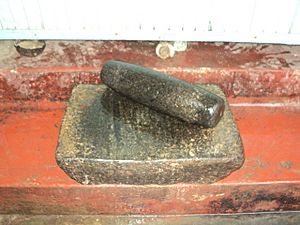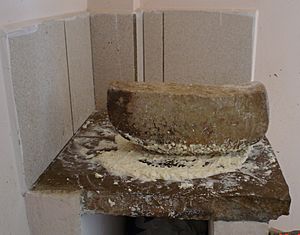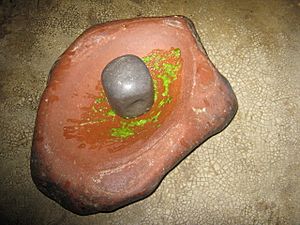Batan (stone) facts for kids
The batán is a special kitchen tool used in many parts of the world, especially in South America and India. It helps people prepare different kinds of food. A batán has two main parts: a large, flat stone (which is also called the batán) and a smaller, grinding stone called an uña.
To use it, you hold the uña with both hands. You then rock it back and forth over the food on the flat batán stone. You can press down hard, lightly, or just let the uña roll. The way you move it depends on what you are trying to make. You can grind food dry, or add water or oil to help. People have been using the batán for a very long time, even before Europeans arrived in South America.
How is a Batán Used?
In South America
In countries like Bolivia, Peru, Ecuador, and Colombia, the batán is a common tool in many homes. People use it in both cities and the countryside. One of its most important uses is to make a spicy sauce called llajwa. Many people believe that llajwa made on a batán tastes much better than when it's made in a modern blender!
The batán is also used for other tasks, such as:
- Removing the outer shell from grains.
- Washing quinoa to remove a bitter coating called saponin.
- Grinding different types of grains.
- Crushing vegetables like papalisa.
- Making small amounts of flour.
In India and Nepal
The batán is also very popular in India, where it is known by different names. In Hindi, it's called "sil-batta." The "sil" is the flat stone, and the "batta" is the grinding stone. In Nepal, it's known as silauto-lohoro.
In different parts of India, it has other names:
- In Maharashtra, it's called pata-varvanta.
- In Tamil and Malayalam, it's known as ammi kallu.
- In West Bengal, it's called "shil nora" and is found in almost every home.
- In Odisha, it's called sila puaa. Here, it's even seen as special and sometimes worshipped as Bhu Devi (Mother Earth) during traditional weddings and the Raja festival.
These grinding stones are mainly used to make chutney (a flavorful sauce) and different spice mixes for cooking. They are also used to grind soaked lentils to prepare foods like dosas, vadas, or papadum.
See also
 In Spanish: Batán (piedra de moler) para niños
In Spanish: Batán (piedra de moler) para niños




